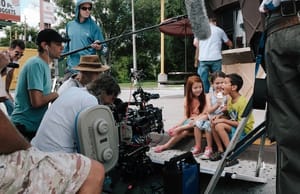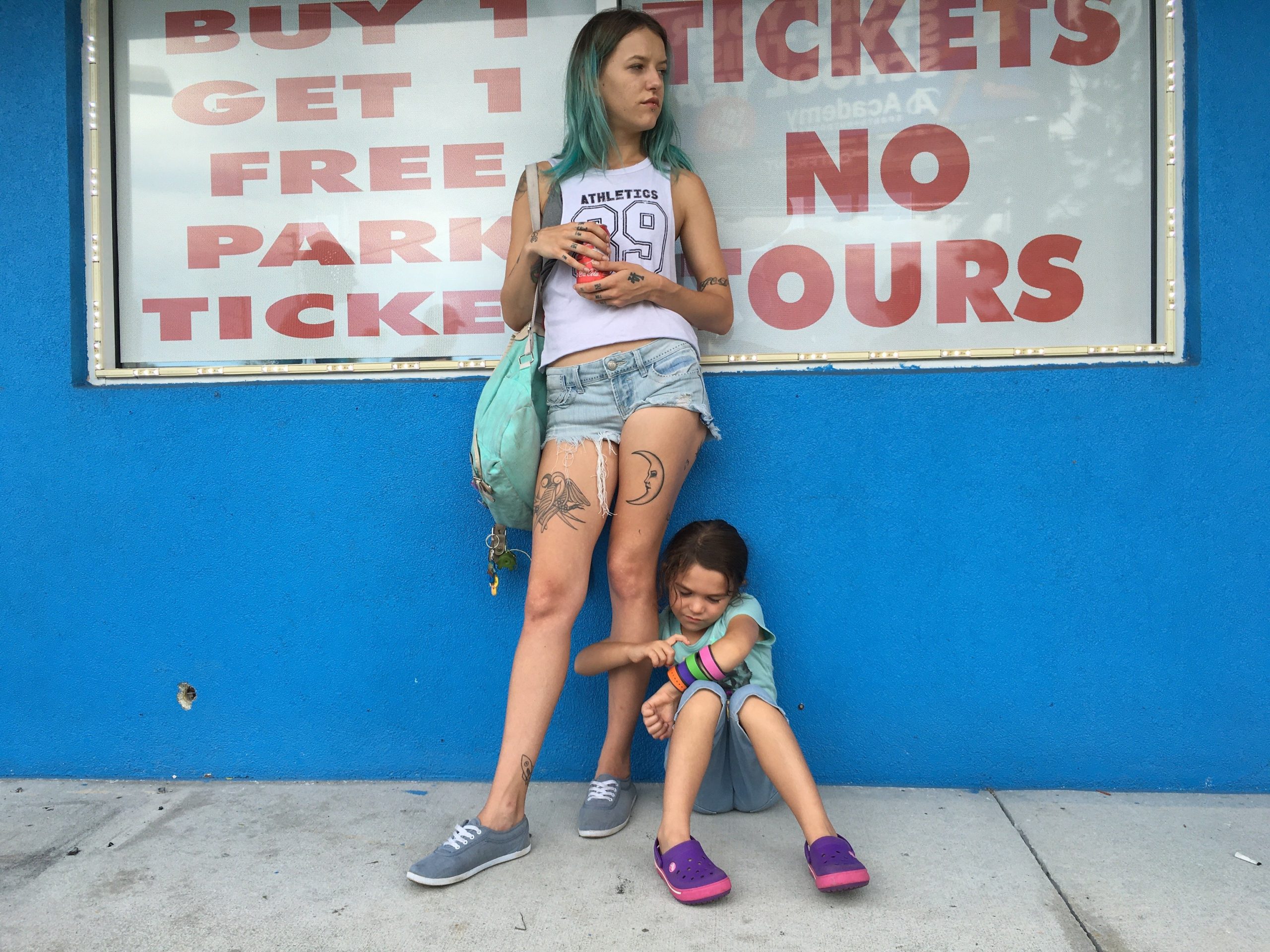
Moviemaker Sean Baker edits his own (brilliant) films—like the 2017 Cannes hit The Florida Project. Here, he argues that each process informs the other.
1. Coverage: You’ll Thank Yourself
Even if I have a clear vision for a scene and I block it out and pre-visualize it, I still kick myself when I don’t get coverage. You’re doing it for safety’s sake, because anything could go wrong. There could be something wrong with continuity, or something in the background, or something technically wrong with the shot. Coverage has saved my ass on so many occasions.
2. Transitioning Between Directing and Editing
I don’t edit right away. This is something that my financiers have been great about—they give me months, which is unheard of. After a shoot, I need to distant myself—to trick myself psychologically—so that I can mimic seeing my own footage for the first time, as an editor seeing raw footage. I don’t even look at the script at that point; I’m just retelling the story with the footage I have.

Little rascals: Christopher Rivera, Brooklynn Prince and Valeria Cotto in The Florida Project. Image courtesy of A24
3. The Case for Cutting Your Film Chronologically
I edit my films chronologically, and I go straight into a fine cut. And I mean really fine: I even do the sound design before moving on. Everybody is like, “That makes no sense. Shouldn’t you be doing an assembly cut?” No. I already know the story, so why not just jump into the fine cut? The style and the vibe of one scene will dictate the style and the vibe of the next scene.
Also, I know that I don’t have enough money for any pick-ups anyway. I put myself in the mental space of a documentary editor—i.e. I have to work with the footage I have.
Cutting chronologically just makes me feel better. Getting to that last scene is a true sense of completion, a real triumph. After five months, on the day when you’re editing the last scene—even though you know there’s so much more work to do, the fine-fine-cutting and moving things around—at least you feel, wow, you’ve gotten to this point. An assembly would take that feeling away.
4. And the Case for Occasionally Jumping Around
Sometimes I am just too tempted to jump ahead. When that happens, I try to choose the easier scenes, the ones where I know the whole scene will just be two or three shots. Then I’ll feel like I accomplished something. For example, the scene in The Florida Project when Bobby (Willem Dafoe) kicks the drug dealers out from his hotel, it’s basically two shots. I had four shots to work with, so I knew it would be an easy night editing, and I’d be done with that scene before morning no matter what.
5. Learn Compositing and Stabilization
They say to never say “fix it in post,” but to tell you the truth, as effects get better and cheaper you can do a lot of fixing in post—if you have a locked down camera. I try to avoid it, of course, but knowing what I can do in editing makes my job a lot easier on set. In the future, I’m going to yell “cut” less when I see a boom, because now I know I can paint that out.
For example, for the opening of Tangerine, where the two protagonists are talking at Donut Time, we had so many issues of continuity with the background traffic because we were shooting an intersection. Sometimes I’d be shooting Mya [Taylor], and the traffic out the window behind her would be going east to west, and then sometimes it’d be going north to south! Thank god that was a locked-down camera, so I was able to change the direction of traffic by just cropping the image and matte-ing the traffic action.
The same trick helped me with comic timing on The Florida Project, too. When the kids are spying on Gloria (Sandy Kane) by peeking over a railing, going, “Boobies!”—because the camera was locked down, I was able to control the timing of which kid’s head came up when. It looked almost like whack-a-mole!
Good stabilization costs a lot of money and some software is better than others, but stabilization is a tool that, as it becomes better and better, I’ll use more often. Look how much Emmanuel Lubezki uses it! I can’t even tell all the shots he uses it on. We had a shot in The Florida Project where we follow Halley (Bria Vinaite) and Moonee (Brooklynn Prince) as they sneak into brunch at a high-end hotel. The shot follows them all the way to the back dining room. We only had time for one take. Everything was wrong with it: You saw a mic pack on Bria, there was a big Star Wars poster in the lobby, there was a boom shadow, the Steadicam moved. I had to fix all of those things, and now the shot works. I stabilized it and it’s totally clean.

Willem Dafoe as Bobby, manager of an Orlando motel, in The Florida Project
6. Consider the Dialogue-Free Take
If I have time on set, I go for an additional take in which there’s no dialogue. I tell the actors, “Just act through the whole scene with no dialogue. You’ll be saying the exact same thing, but with no words.” In Tangerine, we ended up using an entire wordless take for a scene That was what made me decide, from that point on, that I’ll always ask for a dialogue-free take. I may be able to use that stuff. It gives me, as an editor, more options.
7. From iPhones to 35mm, Proxies to 4K
People always ask, “How did you edit Tangerine?” [The 2015 film was shot on the iPhone 5S]. The truth is, once I got in the transcoded H.264 footage into Final Cut, it was like editing anything else. We shot The Florida Project in 35mm, so to make proxies, we decided to scan the entire negative in 2K. Once we edited with the proxies, we went back and rescanned the selects at 4K. Except for the scenes that I was manipulating (punching in on a frame, stabilizing a shot, heavy digital work, etc.)—I would scan those at 6K so I was able to punch in without feeling like the grain would change, and I could keep resolution. In the end, it’s a 4K movie, but some shots were scanned a little higher so we could play with them.
I’m happy that we did this: I really wanted to stay true to film for this one. That said, we did shoot with the Arri Alexa at night and a few shots on iPhone. For the digital shots, we did a film out—I transferred it to 35 and then scanned that 35 back. People might say that was excessive, but I think that it kept the film organic, with that real celluloid feel. We looked at the shots back-to-back: On digital you could literally see the way that light was caught, any brake lights, any strong fluorescents… And as soon as you transferred it to film, it all became one, it became ingrained.
8. Minimal Cuts
I look to use as few edits in a scene as possible. How can I get my point across and have the scene make sense with as few edits as possible? It’s something that we’re all getting away from too much in cinema—we feel like if there’s not a cut every three seconds, something is wrong, and I don’t like that way of thinking.
9. Minimal Runtime
I don’t believe in test screenings at all for my work. It’s about a signature. It sounds snobby, but if my film connects with people, then they probably have a similar sensibility to mine, and that’s all I care about. Yet I am conscious of an audience. I’m very aware of their patience, the size of their bladders. So I look at the runtime of my films. I know that if I push it over a certain amount of time, I’m probably being self-indulgent. Now that film and television have become this blurred mess, if you want to tell a story that’s over three hours, maybe you should be making a series.
In the contract with my financiers for The Florida Project, I said I wouldn’t push it over two hours. I was actually kind of scared to sign that, but I thought, “This is a good exercise; a way of keeping me in check.” The film went a little longer than I thought it would. I had actually cut major sections out of it, but I realized that every time I took something out, it was taking away from the relationship between mother and daughter. The plot wouldn’t change, but the cuts would’ve had a definite impact on the way that we felt about those characters.

Baker has edited all his previous films, including Tangerine (2015). Image courtesy of Magnolia Pictures
10. Post Can Be Maddening…
I have to say that I find editing seriously maddening. I lose my mind in post-production every time. I have a really bad track record: The Florida Project is the first film of mine I’ve edited during which I have not broken up with the person I’m dating! I start living at night, which means waking up at 5 p.m., and at sundown I’m editing until sunup. It’s a weird psychological thing where I feel like it’s the only time I can focus. I can’t get that first creative edit done until 9 p.m. Next thing I know it’s 8 a.m. and the sun’s coming up and my girlfriend’s getting out of bed, and I’m getting into bed, and my dogs are confused. They’re like, “…Walk us?”
11. …But All Directors Should Learn to Edit
It’s very important for directors, even if they’re not going to edit their own films, to understand editing. You don’t need to fully comprehend all the technical stuff, but you have to have some comprehension of it. I know plenty of directors who can’t even turn on a camera, and that’s ridiculous.
I once insulted a lot of directors by saying that editors should be credited as co-directors. I’ve now changed my statement: For my kind of filmmaking, editing is 50 percent of directing. It’s such a strong signature on the film. You’re basically in charge of pacing; I literally rewrite in post-production. It’s the editor’s job to bring it home.
Back when my films weren’t making any money, I edited for a wedding videography company, people’s reels, corporate videos, stuff to pay the bills. This was a low point for me—but even editing wedding videos, at least you’re practicing. I cut my first film on a Steenbeck. Once the negative was cut you were locked. What’s wonderful about nonlinear is you can experiment so quickly. Now I don’t have the time to experiment anymore, though I would like to. So edit other people’s stuff too when you’re cutting your teeth. That stuff you see as grunt work? You should see it as practicing. MM
— As told to Andy Young
This article appears as a chapter introduction in MovieMaker‘s Complete Guide to Making Movies 2018. The Florida Project opens in theaters October 6, 2017, courtesy of A24. Featured image photograph by Marc Schmidt, courtesy of A24.
Share:

